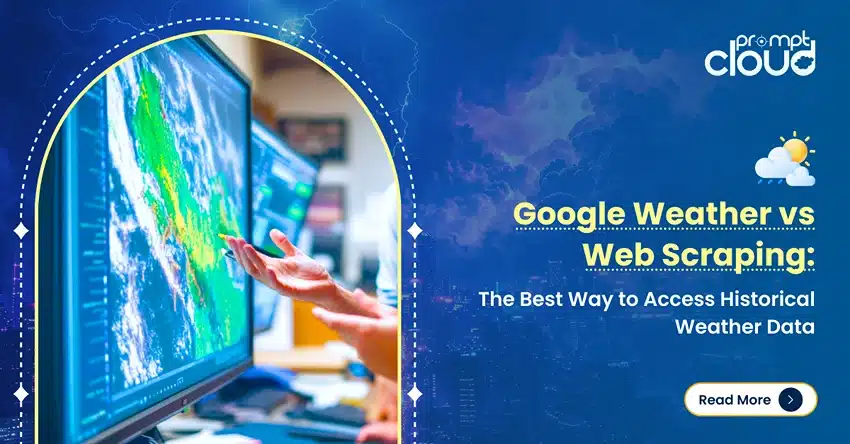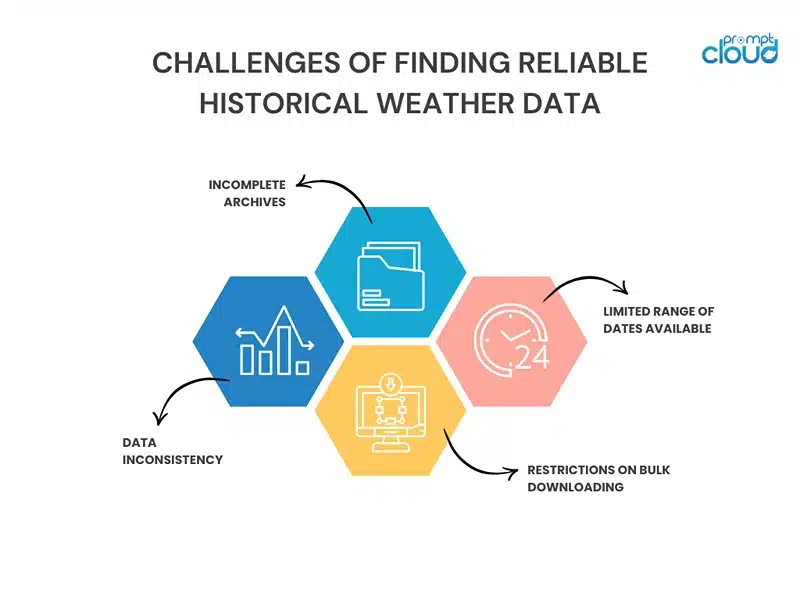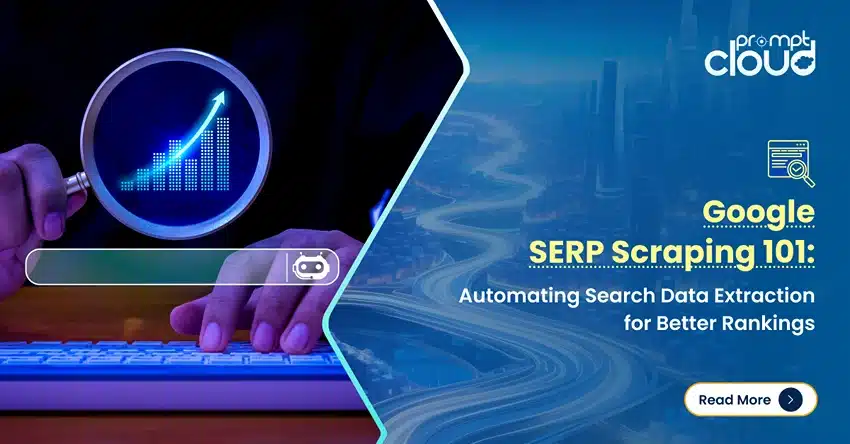
Think back to 2017 when Hurricane Harvey flooded Houston. Or the brutal heatwaves across Europe in 2022.
These weren’t just weather events, they disrupted entire economies.
Crops failed. Insurance claims soared. Flights and supply chains collapsed.
Now imagine you’re an insurance company trying to model future risk without any reliable data from those years. Or a retailer wondering why your sales dipped that summer without realizing it coincided with record-breaking heat.
That’s the real value of historical weather data. It’s not just about nostalgia for a rainy day, it’s about understanding patterns that can shape serious business decisions.
According to NOAA’s National Centers for Environmental Information, the U.S. faced 18 weather-related disasters in 2022 alone, costing a combined $165 billion. Businesses that track historical weather patterns are better positioned to manage risks like these.
The big question is: how do you access historical weather data that’s reliable, detailed, and usable?
You have two main options: Google Weather or web scraping. But they aren’t created equal.
Google Weather: Quick, Easy and Surprisingly Limited for Historical Needs

Image Source: The Verge
Google Weather feels like magic when you just want to know, “Will it rain today?”
You type in your city’s name, and bam — up pops the temperature, humidity, a little cloud icon. Super fast, super simple.
But you’ll quickly hit a wall when you start digging deeper — say you need last December’s rainfall totals for Atlanta, or the average temperature in Chicago across five different winters.
Here’s why:
- No Deep Archives: Google Weather focuses mostly on real-time conditions and short-term forecasts. If you’re hunting for detailed past weather events, you’re out of luck.
- No Google Weather API for Historical Data: Developers can’t easily automate pulling old weather records from Google. It’s built for casual browsing, not serious data gathering.
- Lack of Specifics: Let’s say you want historical weather data by zip code, not just by city. Good luck — Google won’t give you that granular breakdown. It’s surface-level information, at best.
Example:
Imagine a retail chain wants to analyze how weather affected their holiday sales in Dallas zip code 75201 over the last 5 years. With Google, they’d be stuck manually hunting scattered articles or third-party blogs — and probably still come up empty-handed.
Simply put, Google Weather is perfect for your daily “Do I need an umbrella?” check — but not for powering business analytics.
Challenges of Finding Reliable Historical Weather Data

Getting historical weather data sounds easy in theory, but in practice, businesses often run into serious hurdles. Many public sources show weather information for today or the next few days, but when you look for data from five years ago—or even five months ago—you find a different story. Historical archives are either missing, locked behind paywalls, or scattered across multiple platforms.
One of the biggest challenges is incomplete archives. Some platforms may only show general temperature trends without providing other important details like precipitation, wind speeds, or humidity levels. For businesses like crop insurance providers or supply chain managers, these missing pieces make the data almost useless.
Another common issue is the limited range of dates available. A weather app might give you access to the last 30 days of information, but what if you’re analyzing multi-year trends? For instance, an agriculture company studying the impact of changing monsoon patterns over the past 15 years cannot rely on such limited data snapshots.
Even if you do find a promising source, restrictions on bulk downloading can slow you down. Many sites are designed for manual browsing, not for collecting thousands of data points at once. If a retailer wants snowfall patterns across 100 store locations for the past decade, scraping page-by-page manually would be impossible.
Finally, there’s the issue of data inconsistency. Different platforms pull weather records from different meteorological services, using varying measurement standards. A shipping company comparing rainfall data from two ports might find contradictory numbers simply because each platform recorded the storm differently.
These challenges are why many businesses turn toward solutions like web scraping, where they can pull raw data straight from primary sources and maintain consistency across all metrics.
Why Web Scraping Is the Smarter, More Reliable Way to Get Historical Weather Data
Now, if you’re serious about getting historical weather data — especially across large timelines and multiple locations — web scraping is your best friend.
At its core, web scraping means using automated bots to pull detailed weather records directly from reliable sources — think NOAA, Weather Underground, Meteostat, and more — and organizing that data however you need.
Here’s why it beats Google Weather hands down:
1. Full Access to Historical Archives
Need every snowfall record for Denver since 1980? Want rainfall patterns in Miami for each August over the past two decades? Web scraping can gather it — and do it faster than any manual search ever could.
Example:
A logistics company planning their winter delivery routes can scrape decades of snowfall data by city to predict which hubs are most likely to get shut down.
2. Location-Specific Details (Even by Zip Code)
Unlike Google Weather’s vague city-level summaries, scraping lets you drill down to hyper-local detail — sometimes even neighborhood by neighborhood.
Example:
A construction firm needs historical rainfall data in a very specific suburb (say, 94536 in Fremont, California) to evaluate soil drainage risks before breaking ground. Web scraping pulls that niche data easily.
3. Customization and Scalability
Every business has different needs. Some need hourly temperatures; others want monthly averages; others track only extreme weather events like hailstorms. Scraping allows you to custom-tailor the data fields you want, at scale.
Example:
A renewable energy company developing a solar farm project scrapes sunlight hours and cloud cover data going back 25 years — helping them accurately forecast energy output for the next decade.
4. Real-Time and Batch Data Extraction
With web scraping, you’re not stuck in one mode. You can run scrapers in real time (to grab live weather feeds) or in batch mode (to pull historical archives all at once). This flexibility is key for businesses that need both historical analysis and live monitoring.
Example:
An event management company scrapes real-time weather updates during outdoor concerts and mines historical rainfall data months in advance to choose safer event dates.
5. Integrates Easily with Your Business Systems
The scraped weather data isn’t just sitting in a spreadsheet — it can be fed directly into your business intelligence (BI) tools, CRM systems, risk models, or AI forecasts.
Example:
A major airline scrapes weather delay patterns and feeds them straight into their predictive analytics system to automatically adjust flight schedules during storm-prone months.
What to Look for When Sourcing Historical Weather Data
Not all weather datasets are created equal. If you’re planning to use historical weather data for serious business analysis, it’s important to know what to prioritize when sourcing or collecting it.
First, consider granularity. You need to know how detailed the data is. City-wide averages might be enough for some cases, but others require data down to the zip code level. A roofing company in Houston, for instance, might need hailstorm frequency by neighborhood, not just city-wide rainfall statistics.
Next, think about the date range available. A five-year lookback might be sufficient for short-term forecasting models, but industries like agriculture, energy, or infrastructure development often need 20 years of data—or more. A solar farm company trying to forecast returns will want decades of sunlight and cloud cover history before making a multi-million dollar investment.
Update frequency is another key point. Some businesses need daily or even hourly records, especially if timing impacts their operations. A logistics company rerouting trucks based on storm timing would need hourly updates, while a clothing retailer analyzing seasonal trends could manage with monthly averages.
The format of the data also matters. Data collected via web scraping can be exported into CSVs, JSON files, or directly fed into databases and analytics platforms. This flexibility makes it easier for teams to integrate weather data into their existing systems without spending weeks cleaning and reformatting.
Finally, source credibility should never be overlooked. Pulling data from trusted meteorological services ensures your business is not basing major decisions on inaccurate or second-hand information. A resort planning construction in hurricane-prone regions would only trust verified, scientifically gathered data—not an app that estimates weather based on crowdsourced reports.
Choosing the right kind of historical weather data—and collecting it correctly—can make the difference between smart, proactive business strategies and costly missteps.
How Businesses Actually Use Historical Weather Data (Real-World Examples)
Historical weather data powers way more industries than you might think. Here are some ways companies are already using it:
- Agriculture: Farmers analyze past frost dates to choose better planting times. One bad guess can cost an entire season’s harvest.
- Insurance: Insurance firms adjust policy rates based on historical risk zones. After major storms, they use old weather patterns to justify claim rejections or premium hikes.
- Retail: Retailers correlate historical cold snaps with jacket sales. A clothing brand noticed that a sudden November freeze boosted parka sales by 45% in the Midwest — now they time their winter launches smarter.
- Shipping & Logistics: FedEx and UPS use historical storm data to plan backup routes months in advance, minimizing weather-related delays during peak seasons.
Which One Should You Choose — Google Weather or Web Scraping?
If you just want to know if you need a jacket tomorrow, Google Weather works just fine.
But if you need to drive business strategy — forecasting supply chain risks, adjusting insurance models, planning retail campaigns, or even hiring smarter — you need deep, reliable, hyper-local historical weather data.And for that, web scraping is hands down the best way. It offers the depth, accuracy, customization, and scale that businesses can’t afford to miss. At PromptCloud, we specialize in building robust web scraping solutions tailored exactly to your needs — whether that’s historical weather records, salary data, e-commerce prices, or more. Contact us today to get started!


















